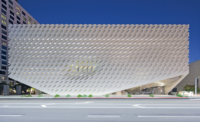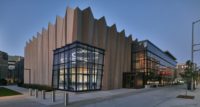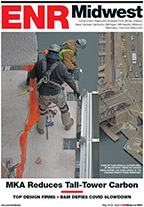Months after a scrapped groundbreaking date for Michigan State University's Eli and Edythe Broad Art Museum had come and gone, its postponement the result of extended design delays, The State News, the university's student paper, reported the $40-million project had hit another potential snag. East Lansing-area trades, the paper noted, were reluctant to bid on it.
As planned, the 46,000-sq-ft facility contained not a single squared-off corner. All vertical surfaces were skewed. Potential bidders would need to extract their own dimensions from 3D models.
"Two-dimensional drawings couldn't accurately depict the project's complex angles," recalls Kara Martini, senior project engineer with Southfield, Mich.-based construction manager Barton Malow. "They only way to render them was in a 3D world."
"Local firms really had to work to get their hands around it," says Dan Bollman, director of engineering and architectural services with Michigan State.
On paper, the design, by London-based Zaha Hadid Architects, was precisely what university planners believed would attract renowned contemporary art exhibits to East Lansing. Along one elevation, its trapezoidal form thrusts forward like the prow of a ship. Skewed, vertically oriented window walls collide with angled bands of pleated stainless steel. On different levels, the structure rises and plunges to varying heights, and at varying angles.
Though Hadid partner Zaha Hadid, who has been dubbed designer of the "unbuildable building," acknowledged the architecture was "enigmatic," she also maintained it conformed to "coherent formal logic." The trouble was, project team members initially couldn't crack it within the allotted budget.
Even before finalizing its contract with Hadid, the winner of an international design competition, the university and the architect "engaged in extended discussions about cost," says Bollman. Following negotiations with the candidate, Michigan State revised the budget upward, to $40 million from $30 million.
During schematics, cost estimates ballooned past $100 million as team members sought to manipulate Broad's glass-and-steel enclosure in a manner that rendered it self-supporting, "so that it functioned like an exo-skeleton," says Kevin Marshall, project architect with Integrated Design Solutions (IDS), the project's Troy, Mich.-based architect-of-record.
"Many of those earlier schemes probably would have wound up in the unbuildable category," adds Paul Stachowiak, IDS president.








Post a comment to this article
Report Abusive Comment